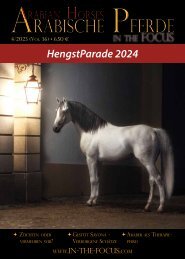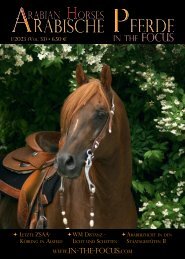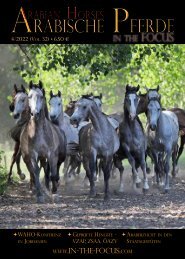Arabische Pferde IN THE FOCUS 4/2020 (Vol. 24) - public
Zeitschrift für Liebhaber und Züchter Arabischer Pferde
Zeitschrift für Liebhaber und Züchter Arabischer Pferde
Sie wollen auch ein ePaper? Erhöhen Sie die Reichweite Ihrer Titel.
YUMPU macht aus Druck-PDFs automatisch weboptimierte ePaper, die Google liebt.
DNA research in Horses<br />
Bairaktar's acquittal<br />
Wissenschaft<br />
Warmblood fragile foal syndrome (WFFS) has become a<br />
horror in recent years in Warmblood breeding. But because<br />
similar symptoms to WFFS have also been found in (historic)<br />
Arabian horses, research has been conducted whether<br />
or not Bairaktar, who had a significant influence on Warmblood<br />
breeding, was the origin of WFFS.<br />
Warmblood fragile foal syndrome<br />
(WFFS) is a hereditary disease, an<br />
autosomal recessive disorder caused<br />
by a single nucleotide variant, that causes<br />
an incurable connective tissue disorder.<br />
It can be detected immediately after birth,<br />
when the foal usually gives a somewhat<br />
weak impression, but still seems to be okay<br />
with an existing sucking reflex. However,<br />
due to the genetic defect, the skin (epidermis)<br />
is not firmly connected to the lower tissues,<br />
which means that it may tear off even<br />
with only slight contact and stress, such as<br />
when trying to get up. No need to say, that<br />
the foals cannot survive.<br />
Similar disease in 1855<br />
These symptoms sounded very much like a<br />
disease, which was first described in 1855 by<br />
Prof. Adolph Rueff at Hohenheim. In the years<br />
between 1841 and 1853, a „peculiar skin<br />
disease was observed in several foals born at<br />
the Royal Stud Weil in Württemberg: The foals<br />
were mostly born dead, or died at birth or<br />
soon after, and all displayed the same congenital<br />
malformations of the skin and the<br />
hooves. The skin, especially on the legs, but<br />
also on the back, the neck, and the face, was<br />
usually hairless, there were cysts filled with<br />
fluid, the upper skin detached from the layer<br />
beneath, the hooves shrank before birth and<br />
fell off in the womb or shortly after birth,<br />
and the oral mucosa was also affected.”<br />
Based on the description of the symptoms,<br />
we can today identify this condition as epitheliogenesis<br />
imperfecta (EI) or junctional<br />
epidermolysis bullosa (JEB). Professor Rueff<br />
also observed that all affected horses were<br />
grey and descended from the stallion Amurath<br />
I 1829, whether in the first, second, or<br />
third generation. In other words, Rueff identified<br />
the cause as grey colouring, inbreeding,<br />
and descent from Amurath I. He wrote:<br />
„As for eliminating this curse, the obvious<br />
strategy would be to stop using this stallion,<br />
in particular to avoid inbreeding, and in<br />
my opinion this would quickly and certainly<br />
achieve the desired result. However – the<br />
stallion is of such great significance, that it<br />
would be a disaster for the stud if he were<br />
to be so condemned, and it would be highly<br />
regrettable if nature itself would end the disease<br />
by the death of the stallion (who is already<br />
25 years old). Thus, as long as the stallion<br />
lives, it should be considered how the<br />
problem might be solved without resorting<br />
to such very unfortunate radical means.”<br />
Inbreeding brought it to light<br />
We may doubt today if the grey colour is in<br />
any way connected to the above disease, as<br />
this condition today occurs only in Belgian<br />
Draft Horses (chestnuts) and American<br />
Saddlebreds, where it is clearly not linked<br />
to the grey colour. The fact that the affected<br />
horses at Weil were grey is easily explained<br />
by the fact that it was the most common colour<br />
in the Weil herd, especially among the<br />
descendants of Bairaktar and Amurath I.<br />
Rueff’s observation that inbreeding and descent<br />
from Amurath I might be the cause, is<br />
supported by the affected foals’ parentage.<br />
It you examine their pedigrees, you will see<br />
that Amurath’s sire Bairaktar db appears<br />
each time both on the sire’s and on the dam’s<br />
side. There is only one exception, the 1846<br />
foal out of Kaaba II, whose symptoms were<br />
not identical to the others.<br />
We have to remember that in 1855, the<br />
laws of Mendelian inheritance were not yet<br />
known; Gregor Mendel only published them<br />
in 1866. Today we know that EI and JEB are<br />
passed on by autosomal recessive inheritance<br />
(as are CA and SCID); this means that<br />
it is not linked to gender, and both parents<br />
have to be carriers. Carriers appear perfectly<br />
healthy themselves, and only when the<br />
defective gene is inherited from both parents,<br />
making the foal homozygous for this<br />
trait, will it be affected and die. If we assume<br />
that Amurath I 1829 was a carrier, the mares<br />
must have been carriers as well. These<br />
however, with very few exceptions, were not<br />
descended from Amurath I, but from Amurath’s<br />
sire, Bairaktar Or.Ar. In other words,<br />
we may assume that Bairaktar Or.Ar. introduced<br />
this condition to the stud. But it only<br />
manifested itself when his daughters were<br />
bred to Amurath I, making them inbred to<br />
Bairaktar Or.Ar.<br />
Distribution of WFFS<br />
Back to today’s WFFS: A group of researchers<br />
(Reiter, Wallner, Brem from the University of<br />
Veterinary Medicine Vienna, et. al.) investigated<br />
the breed distribution of the WFFS<br />
allele. All in all, 4081 horses belonging to 38<br />
different breeds were screened. In total, 4.9<br />
% of the horses representing 21 breeds carried<br />
the WFFS allele. The affected breeds were<br />
mainly warmbloods, with carrier frequency<br />
as high as 17 % in the Hanoverian and Danish<br />
Warmblood. The WFFS allele was not<br />
detected in most non-warmblood breeds.<br />
Exceptions include WFFS carriers in the Thoroughbred<br />
(17/716), Haflinger (2/48), American<br />
Sport Pony (1/12), and Knabstrupper<br />
(3/46). But all of the 302 Arabians in this investigation<br />
were free of the mutated allele.<br />
Considering the huge impact the stallion<br />
Bairaktar had on Warmblood breeding<br />
through his great-great-great-grandson<br />
Amurath 1881, and the fact that Bairaktar<br />
appears several hundred times in some<br />
Warmblood pedigrees, such as Cornet<br />
Obolensky, Sandro Hit or Valegro, the researchers<br />
wanted to investigate this track<br />
further. They then asked for a tooth of<br />
Bairaktar, to extract and analyze his DNA.<br />
Bairaktar’s skeleton is property of the University<br />
of Hohenheim, is on permanent lease<br />
to the State Stud Marbach and exhibited<br />
at the horse museum at Offenhausen. DNA<br />
extraction was performed in the cleanroom<br />
of the laboratory at the Natural History Museum<br />
in Vienna, following standard procedures<br />
to avoid contamination, using one<br />
of the molars of Bairaktar. The result clearly<br />
showed that he did not carry the mutated<br />
allele. This, together with the fact that all<br />
Arabians in this investigation were free of<br />
the mutated allele, of which 16 mares and<br />
3 stallions were used in the Polish breeding<br />
program and traced to Bairaktar, acquitted<br />
the desert-bred Arabian Bairaktar from<br />
being the origin of WFFS. To date, the exact<br />
origin of WFFS is unclear.<br />
Gudrun Waiditschka<br />
74<br />
© ARABISCHE PFERDE - <strong>IN</strong> <strong>THE</strong> <strong>FOCUS</strong> 4/<strong>2020</strong>
















